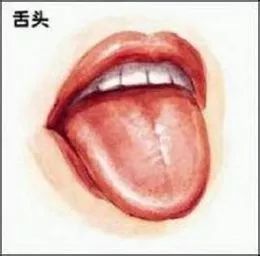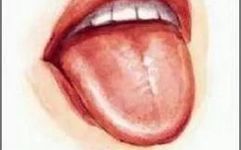This official account is managed by the National Administration of Traditional Chinese Medicine. If you have not followed us yet, please click the blue “Chinese Medicine” above to follow.
In Traditional Chinese Medicine (TCM), the tongue is connected to the internal organs through the circulation of meridians and tendons. Observing the tongue primarily involves examining the tongue’s quality, coating, and shape changes. TCM divides the tongue into four parts: the tip, middle, root, and sides, which reflect the pathological changes of the heart and lungs, spleen and stomach, kidneys, and liver and gallbladder, respectively.

Observing Tongue Appearance
Observing the tongue appearance mainly involves examining the changes in the tongue body and its color, which reflect the changes in the internal organs, qi and blood, and deficiency or excess conditions.
A tongue with a pale red color, moist, and white with a hint of red indicates good health. A pale white tongue generally signifies qi and blood deficiency or a cold constitution, often seen after severe illness, prolonged illness, or in those with congenital deficiencies. A red tongue indicates a heat syndrome; a red tip suggests excessive heart fire, commonly associated with irritability and insomnia; a red edge indicates excessive liver and gallbladder fire, often seen in irritability; a red middle indicates excessive stomach fire, commonly associated with heartburn and acid reflux.
Blood stasis points on both sides of the tongue are caused by endocrine metabolic disorders and pigmentation, commonly seen in menopausal women. A bluish-purple tongue is also common; a uniformly bluish tongue indicates a cold syndrome, often seen during severe chest or abdominal pain; localized bluish-purple spots or stasis points are often seen in modern patients with fatty liver, cirrhosis, or tumors; smokers and heavy drinkers often have a purple tongue due to internal heat and toxins obstructing the meridians.
A swollen tongue is often related to phlegm, dampness, heat, or toxins. A thin, dry tongue usually indicates deficiency of yin and blood, with excessive fire. A tongue that frequently extends beyond the lips, known as “protruding tongue,” is often seen in infants with heart and spleen heat. A short, red tongue indicates internal phlegm and dampness obstruction. A tightly contracted tongue that cannot extend usually indicates a severe condition.
If the tongue deviates to one side when extended, it is a sign of hypoglossal nerve paralysis on that side; patients with hyperthyroidism and neuroses often exhibit tremors when extending the tongue. A soft, contracted tongue that lacks strength indicates deficiency of both qi and blood, with loss of nourishment to the tendons and meridians. A hard root of the tongue with unclear speech often indicates a precursor to a stroke.
Examining the Tongue Coating
In TCM, the tongue coating is generated by stomach qi, which is the original driving force of qi and blood in the body. The tongue coating reflects the condition of fluids and digestion in the stomach, and the examination focuses on its color, thickness, moisture, and whether it is greasy, peeling, etc.
The coating color mainly includes white, yellow, gray, and black. A white coating indicates exterior syndrome and cold syndrome, usually indicating a milder condition. A yellow coating generally indicates interior syndrome and heat syndrome. A gray coating often indicates interior syndrome, while a black coating usually indicates a severe condition.
A healthy person’s tongue coating is often thin, white, and moist. A thick coating, sparse coating, or peeling coating are all signs of disease. If the tongue surface has coating but is partially peeled, it indicates damage to stomach qi or stomach yin, also seen in vitamin deficiencies. A greasy coating indicates phlegm and dampness; ancient texts state, “Strange diseases often arise from phlegm,” which requires attention. If the coating is loose and has larger particles, with thick edges on the sides and middle of the tongue, resembling tofu dregs, it indicates food accumulation in the gastrointestinal tract, commonly referred to as “overeating.”
A small area in the middle of the tongue without coating often indicates a lack of nutrition and reduced secretion of saliva; bluish-purple stripes or irregular black spots and stasis points on the edges of the tongue are often seen in women with menstrual disorders, dysmenorrhea, or functional uterine bleeding, and may also indicate early adrenal cortex insufficiency. If the tongue coating suddenly disappears, leaving a smooth surface like a mirror, it indicates a critical condition of both stomach yin and qi deficiency. A dry coating indicates damage to body fluids, which can be seen in some diabetic patients. A slippery coating indicates fluid accumulation, often seen in kidney disease, usually accompanied by edema, abdominal distension, nausea, and dizziness.
For superficial pathogenic factors, the coating is often thin, white, and not dry, commonly seen in the early stages of disease or in chronic diseases that are not severe; as the pathogenic factors deepen, the coating gradually changes from white to yellow, from thin to thick, and from moist to dry, often seen in dehydration or acidosis. A change in coating from white to yellow, from yellow to retreat, and then to the reappearance of new thin white coating indicates a favorable prognosis; a change from white to gray, from gray to black indicates a worsening condition. If the tongue resembles a peeled pig’s kidney, mirror-like, or cake-like, it indicates a gradual loss of stomach qi, often associated with a severe prognosis.
Geographic tongue is characterized by one or more areas of peeling coating, with the edges of the peeling raised like a frame, resembling a map. A mirror tongue is when the entire coating is lost, leaving a smooth surface like a mirror, with a red tongue body, also known as mirror red tongue. Clinically, geographic tongue and mirror tongue are often seen in patients with indigestion and chronic diarrhea, with geographic tongue being more common in children with poor gastrointestinal function.
Generally, the changes in tongue quality and coating are unified, and the main disease is a combination of both. For example, internal heat is often associated with a yellow coating and red tongue; internal deficiency and cold are often associated with a white coating and pale tongue. When heat pathogens are prevalent, body fluids are consumed, leading to a dry coating; when cold and dampness are stagnant, body fluids rise, leading to a slippery coating. However, during the disease process, due to the complex changes between the body’s internal organs, qi and blood, and pathogenic factors, there may be cases where the tongue quality and coating do not match, but with detailed and comprehensive analysis, it is not difficult to find their relationship, which requires long-term observation in clinical practice.
The Spirit of the Tongue and Stomach Qi
The spirit of the tongue is part of the overall spirit of the body, and the basic characteristics of the tongue spirit are reflected in the tongue appearance, mainly in the tongue color and movement. A tongue that is red, vibrant, moist, and moves freely indicates a strong spirit; a dull, dry, and stiff tongue indicates a weak spirit, with the color being a key point for differentiation. A spirited tongue indicates sufficient righteous qi and vitality, and even in illness, it suggests a good prognosis; a tongue lacking spirit indicates weakened righteous qi and diminished vitality, suggesting a poor prognosis. The “Simple Examination of External Diagnosis” states: “Regardless of the color of the tongue coating, it is easy to treat; if the tongue quality changes, one must observe its color for vitality. A spirited tongue shows subtle signs of red vitality, indicating merely stagnation of blood and qi, not the failure of organ qi; a lifeless tongue shows complete change, dryness, dullness, and lack of vitality, indicating failure of organ qi, known as the true color of the organ.”
To determine whether the tongue has stomach qi, one mainly observes whether the tongue coating has a root. A rooted coating is a sign of stomach qi. A coating without a root indicates weakened stomach qi, signifying a lack of stomach qi.
In summary, a tongue appearance with spirit and stomach qi indicates that the righteous qi is not weakened, suggesting a milder condition, or even if the condition is severe, it has a good prognosis; a tongue appearance lacking spirit and stomach qi often indicates weakened righteous qi, suggesting a more severe condition or difficulty in recovery, with a poor prognosis.
Content Source: China Traditional Chinese Medicine News
Author: Ouyang Jun
Image Source: Internet (Infringement will be removed)
Editor: Wang Di
Reviewed by: Lu Jing Supervisor: Zhu Luyun
China Traditional Chinese Medicine
WeChat ID: satcm01


